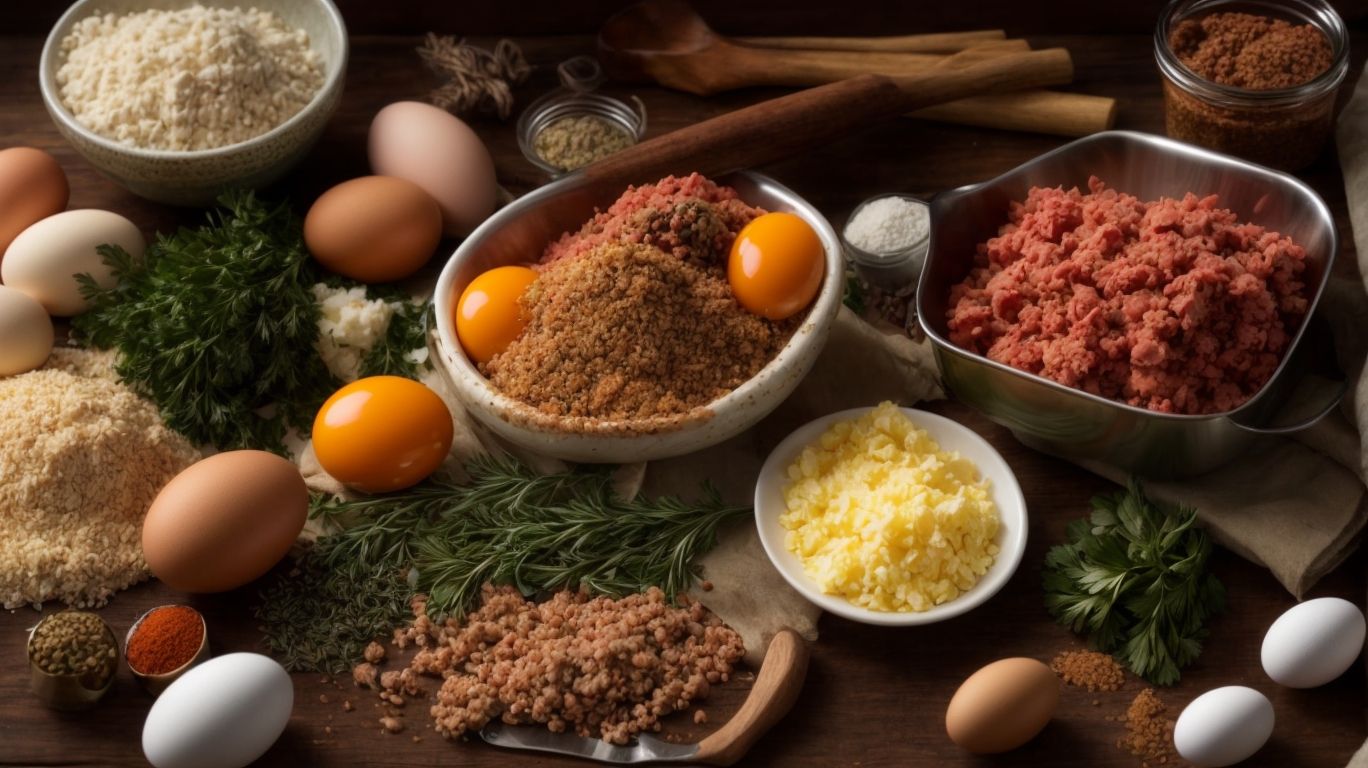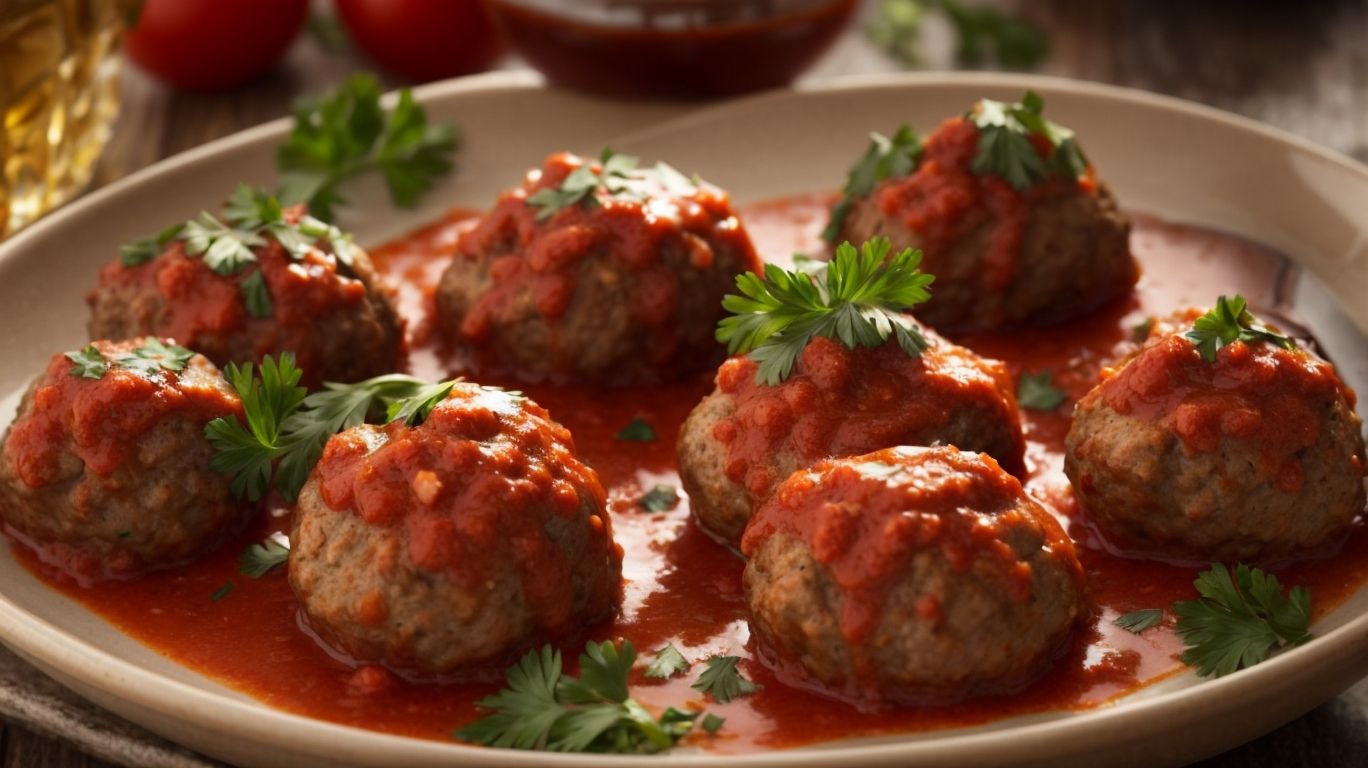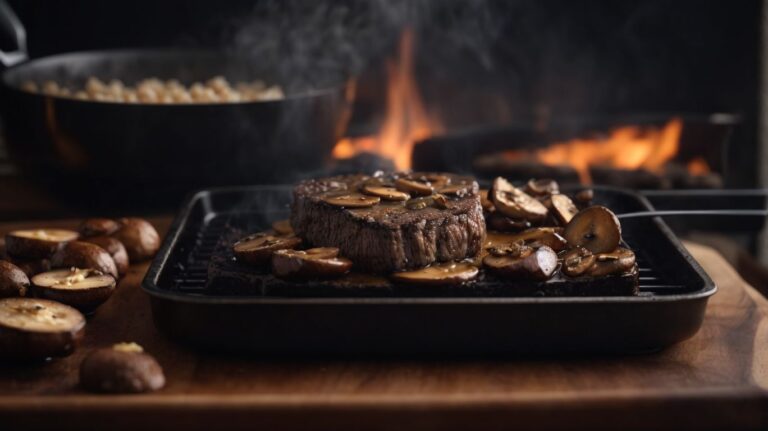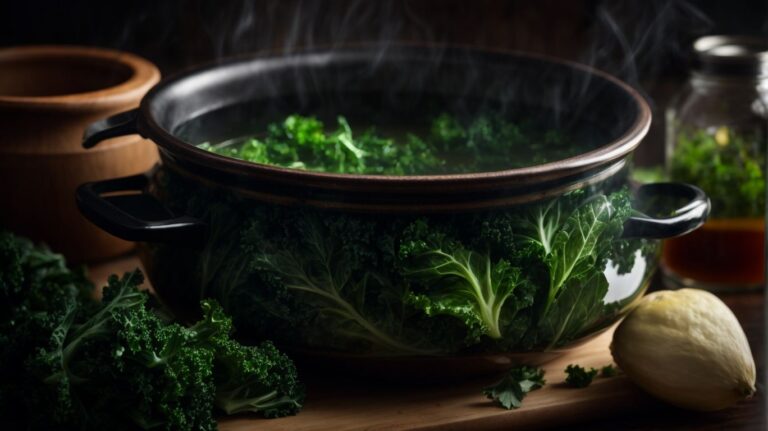How to Cook Meatballs?
Are you a fan of meatballs but unsure of how to make them at home?
In this article, we will explore everything you need to know about cooking delicious meatballs.
From the history of this beloved dish to the different types of meatballs, we will cover it all.
Join me, Chris Poormet, an award-winning culinary blogger and former chef, as we delve into the world of meatballs.
Get ready to learn about the best ingredients, steps to making perfect meatballs, and serving suggestions that will elevate your meatball game.
Let’s get cooking!
Key Takeaways:
About the Author: Chris Poormet
Chris Poormet, the accomplished owner of Poormet.com, is not only a former chef with expertise in food photography but also the proud recipient of the prestigious title ‘Culinary Blogger of the Year.’
His blog, Poormet.com, has become a go-to destination for food enthusiasts seeking culinary inspiration and guidance. With a keen eye for detail, Chris’s food photography captures the essence and flavors of his dishes, enticing viewers to try the recipes themselves.
Chris’s background as a former chef brings a unique perspective to his culinary creations, blending his practical experience with a creative flair that sets him apart in the industry.
His exceptional talent and dedication to his craft have earned him the esteemed recognition of ‘Culinary Blogger of the Year,’ solidifying his reputation as a respected authority in the culinary world.
What are Meatballs?
Meatballs are versatile culinary creations made by combining ground meat with various seasonings and binders to form small, flavorful balls that can be cooked in a variety of ways.
One of the key aspects of meatballs is their adaptability in different cuisines across the globe. Whether simmered in a rich tomato sauce, skewered on sticks for a flavorful appetizer, or added to hearty soups and stews, meatballs showcase a remarkable range of flavors and textures. The choice of ground meat, whether beef, pork, chicken, or even vegetarian options, coupled with aromatic seasonings like garlic, herbs, and spices, creates an explosion of taste in every bite. The binders, such as breadcrumbs, eggs, or cheese, not only hold the meatball together but also add depth to the dish. Depending on the culinary tradition or personal preference, meatballs can be shaped into various sizes, from bite-sized morsels to substantial servings, offering a delightful dining experience for all.
History of Meatballs
The history of meatballs dates back centuries, with various cultures contributing their unique twists to this beloved dish, showcasing its evolution from a humble meal to a culinary staple enjoyed worldwide.
Originating in ancient Rome, where seasoned meat mixtures were formed into small balls, this concept spread through conquests, trade routes, and immigration, morphing into the flavorful meatballs we know today. In Italy, the famous Italian ‘polpette’ gained popularity, using ingredients like Parmesan, garlic, and parsley, reflecting the country’s rich culinary heritage.
Types of Meatballs

Credits: Poormet.Com – Walter Ramirez
Meatballs come in various forms, with popular types including Italian meatballs known for their rich flavors, Swedish meatballs recognized for their creamy sauce, and Asian-style meatballs offering a fusion of different culinary influences.
Italian meatballs, also known as ‘polpette’ in Italian cuisine, are typically made with a combination of ground meat, breadcrumbs, Parmesan cheese, herbs like parsley and basil, and sometimes soaked in milk for tenderness. These meatballs are usually simmered in a marinara sauce or served with pasta.
On the other hand, Swedish meatballs made with a mixture of ground beef and pork are well-loved for their distinct creamy gravy, often flavored with nutmeg and allspice, creating a unique and comforting taste.
In contrast, Asian-style meatballs encompass a broader spectrum, blending flavors like soy sauce, ginger, garlic, and sometimes hoisin sauce, offering a harmonious balance of sweet, salty, and savory notes.
Italian Meatballs
Italian Meatballs are a classic Italian dish made with a blend of ground beef and Italian sausage, seasoned with garlic powder, Parmesan, and breadcrumbs, resulting in a flavorful and hearty meal.
Italian sausage is the key ingredient that provides a robust and rich flavor to the meatballs. The combination of herbs and seasonings like parsley, oregano, and basil gives them an authentic Italian taste.
The breadcrumbs not only bind the ingredients but also add a nice texture when cooked. Freshly grated Parmesan cheese adds a nutty and salty kick to the dish, enhancing its depth of flavor.
When forming the meatballs, it’s essential to ensure they are rolled uniformly for even cooking. Cooking them in a savory tomato sauce infuses the meatballs with additional flavors, making them even more delectable.
Swedish Meatballs
Swedish Meatballs are a traditional Swedish delicacy served with a creamy gravy over a bed of buttery mashed potatoes, offering a comforting and savory dining experience.
The distinctive flavors of Swedish meatballs, prepared with a blend of ground meat, breadcrumbs, and subtle spices, create a rich and hearty mouthful. The creamy gravy, often seasoned with hints of herbs and spices, enhances the dish by providing a luscious coating that complements the tender meatballs perfectly. The smooth and velvety mashed potatoes, a classic accompaniment, balance the robust flavors of the meatballs, creating a harmonious combination that appeals to a wide range of palates.
Asian-style Meatballs
Asian-style Meatballs feature a unique blend of flavors and seasoning, drawing inspiration from various Asian cuisines to create a fusion dish that delights the palate with its aromatic and bold taste.
These meatballs often incorporate a mix of ingredients like soy sauce, ginger, garlic, and green onions, infusing each bite with a burst of umami goodness. The use of Asian-inspired seasonings like sesame oil or hoisin sauce adds depth and complexity to the dish, elevating it beyond traditional meatball recipes.
What sets Asian-style meatballs apart is the balance of sweet, savory, and spicy notes that come together harmoniously in each bite. Some variations may feature a hint of heat from chili paste or the subtle sweetness of mirin, offering a delightful contrast of flavors that dance on the taste buds.
Ingredients for Meatballs

Credits: Poormet.Com – Michael Sanchez
The key components for crafting delectable meatballs include carefully selected meats, binders to hold the mixture together, and an array of seasonings to enhance the flavor profile of the dish.
Regarding choosing the perfect meat for meatballs, a combination of ground beef and pork is commonly used for its rich flavor and moisture content. Mixing these two meats provides a balance of lean and fat, resulting in juicy and tender meatballs. Breadcrumbs, eggs, and grated cheese are popular binders that help bind the ingredients together.
- The seasoning play a crucial role in elevating the taste of meatballs, with ingredients like garlic, onion, parsley, and Italian seasoning adding depth and complexity to the flavor profile.
- Experimenting with different seasonings such as paprika, oregano, or chili flakes can add a unique twist and cater to individual preferences.
What Meat to Use?
When selecting meat for meatballs, options like ground beef for a classic flavor, ground pork for richness, or ground turkey for a leaner alternative offer versatile choices to cater to different preferences.
- Ground beef, with its higher fat content, is perfect for those seeking a juicy and flavorful meatball.
- Ground pork, on the other hand, adds a luxurious richness and tenderness that can elevate the taste profile of your meatball recipe.
- Ground turkey, being leaner, provides a lighter and healthier option without compromising on taste.
What Binder to Use?
Binders like eggs and breadcrumbs play a crucial role in meatball preparation, aiding in holding the mixture together and adding texture to the final dish.
Eggs serve as a binding agent in meatballs by coagulating when cooked, thus helping to keep the ingredients cohesive. They contribute moisture and richness to the mixture, enhancing the overall flavor. On the other hand, breadcrumbs not only absorb excess moisture but also provide structure, preventing the meatballs from becoming too dense. The combination of these two binders results in meatballs that are tender, juicy, and well-structured, making them a beloved dish in many culinary traditions.
What Seasonings to Use?
Seasonings used in meatballs can vary from classic Italian blends to exotic spice mixes, offering a versatile range of flavor profiles to suit different tastes and preferences.
Garlic and onion powders are common staples for adding depth and savory notes to meatballs, while paprika and cumin bring a hint of smokiness and warmth. For those seeking a kick of heat, cayenne pepper or crushed red pepper flakes can intensify the flavor. Fresh herbs like parsley or basil can provide a burst of freshness, and unique seasonings such as garam masala or za’atar offer a creative twist to traditional meatball recipes.
Steps to Making Meatballs

Credits: Poormet.Com – Juan Hall
Crafting delectable meatballs involves a series of steps, starting from mixing the ingredients to forming the perfect balls and concluding with cooking them using preferred methods for a mouthwatering result.
For the mixing process, combine ground meat with breadcrumbs, finely chopped onions, minced garlic, herbs, and seasonings in a mixing bowl. The key here is to ensure that all the ingredients are evenly distributed throughout the mixture for consistent flavor. Once the mixture is well combined, proceed to form the meatballs by rolling portions of the mixture between your palms to create uniform balls. To cook the meatballs, you can choose to either bake them in the oven, fry them in a pan, or simmer them in a savory sauce to enhance their taste.
Mixing the Ingredients
The initial step in making meatballs involves expertly mixing ground meat, seasonings, and eggs to create a well-blended mixture that forms the foundation of flavorful meatballs.
Ground meat is typically combined with seasonings like salt, pepper, garlic powder, and herbs to infuse the meat with delicious flavors. The eggs act as a binding agent, helping to hold the meatball mixture together while also adding moisture and richness. Ensuring that all the ingredients are uniformly mixed is crucial to achieve consistent texture and taste in each meatball.
Forming the Meatballs
Forming meatballs requires careful shaping of the mixture into uniform balls, ensuring consistent size and shape to promote even cooking and presentation appeal.
The technique of shaping meatballs is crucial in ensuring an even distribution of flavors and textures in each bite. By rolling the mixture with gentle pressure between your palms, you can create perfectly round meatballs. It’s important to aim for a consistent size to ensure that they cook evenly. Some cooks use specialized scoops or spoons to measure out the mixture, providing uniformity in size. Maintaining a consistent shape not only enhances the visual appeal but also helps in cooking the meatballs evenly.
Cooking the Meatballs
Cooking meatballs can be accomplished using versatile methods like skillet searing for a crispy exterior or oven baking for a hands-off approach, offering flexibility to cater to different preferences.
Skillet searing involves browning the meatballs in a hot skillet with a bit of oil, creating a flavorful crust while locking in moisture. It’s a quick and efficient method that adds a delightful texture to the meatballs. On the other hand, oven baking allows for a more hands-off cooking process, ideal for large batches. By placing the meatballs on a baking sheet and cooking them in the oven, you ensure even cooking and a juicy interior.
Tips for Perfectly Cooked Meatballs
Achieving perfectly cooked meatballs requires attention to detail, such as using a meat thermometer for precision, avoiding overmixing the ingredients, and utilizing an ice cream scoop for uniform sizing.
When using a meat thermometer, insert it into the center of a meatball to ensure it reaches the optimal internal temperature, typically around 160°F for beef and pork.
Overmixing the ingredients can make the texture tough; instead, gently combine the meat and other components until just incorporated for tender meatballs.
An ice cream scoop not only helps in portioning out the mixture evenly but also shapes them quickly and consistently, resulting in beautifully round meatballs that cook uniformly.
Use a Meat Thermometer
Employing a meat thermometer is essential to ensure meatballs reach the optimal internal temperature, guaranteeing safe consumption and perfect doneness.
Meat thermometers act as your culinary guardian angel, preventing undercooked or overcooked meatballs, which not only affects taste but also poses health risks. By using a meat thermometer, you can be confident in serving juicy and flavorful meatballs without any concerns about potential foodborne illnesses.
The precision of a meat thermometer allows you to achieve the exact level of doneness you desire, whether it’s medium-rare or well-done, ensuring a delightful dining experience for yourself and your guests. It’s a small tool with a significant impact on your cooking outcomes.
Don’t Overmix the Ingredients
Overmixing the meatball ingredients can lead to a dense and tough texture, so it is crucial to gently mix the components until just combined to achieve a tender and flavorful outcome.
When meatball ingredients are overmixed, the proteins in the meat can get overly compacted and squeezed out, resulting in a loss of moisture and tenderness. Overmix can break down the fat in the meat, making the final product dry and less succulent. To avoid this, gently folding the ingredients together helps preserve the juiciness and delicate flavor of the meatballs.
Use an Ice Cream Scoop for Evenly Sized Meatballs
Utilizing an ice cream scoop for portioning meatball mixture ensures consistent sizing, leading to even cooking and a visually appealing presentation of uniformly shaped meatballs.
Using an ice cream scoop eliminates the guesswork associated with eyeballing portions, ensuring that each meatball is approximately the same size for consistent results. This method also speeds up the preparation process by providing a quick and efficient way to shape the meat mixture without the need for messy hands. The uniform shape achieved with an ice cream scoop not only enhances the overall aesthetics of the dish but also promotes even cooking, resulting in perfectly cooked meatballs every time.
Serving Suggestions for Meatballs

Credits: Poormet.Com – Mason Hill
Meatballs offer a multitude of serving possibilities, ranging from classic pairings like spaghetti and meatballs to creative options such as meatball subs and delectable meatball appetizers for diverse dining experiences.
For a comforting and traditional meal, serving meatballs with a rich tomato sauce over a bed of al dente spaghetti is a timeless favorite. The marriage of juicy meatballs and the flavorful pasta creates a satisfying and hearty dish that is beloved by many.
On the other hand, if you’re looking to switch things up, consider making tantalizing meatball subs. Place savory meatballs in a crusty roll, add some melted cheese and marinara sauce, and you have a mouthwatering sandwich bursting with flavors.
For a more elegant approach, turn meatballs into delectable appetizers by skewering them with colorful veggies and serving with a variety of dipping sauces. These bite-sized treats are perfect for parties and gatherings, offering a fun twist on a classic dish.
Traditional Spaghetti and Meatballs
The classic combination of spaghetti and meatballs, smothered in rich red sauce, is a timeless favorite that showcases the perfect harmony of savory meatballs and flavorful spaghetti sauce.
Spaghetti and meatballs, a quintessential Italian-American dish, offer comfort and nostalgia with each bite. The al dente strands of spaghetti are a perfect vehicle for soaking up the delicious richness of the tomato-based sauce.
The meatballs, often a blend of ground beef, pork, and veal, are seasoned with herbs and spices, adding depth and complexity to the dish. They are tender, moist, and bursting with flavor, complementing the tanginess of the spaghetti sauce.
The secret to a stellar spaghetti and meatballs dish lies in the simmering of the meatballs in the spaghetti sauce to allow all the flavors to meld together, creating a symphony of taste that delights the senses.
Meatball Subs
Meatball Subs, featuring tender meatballs nestled in a soft roll and topped with savory sauce, provide a satisfying and handheld twist on the classic meatball experience.
When preparing meatball subs, it all starts with the perfectly seasoned meatballs, typically a blend of ground beef, pork, and spices to create a flavorful fusion. The bread used for the roll should be soft yet substantial, able to hold the meatballs and sauce without becoming soggy. The sauce, a crucial component, can vary from tangy marinara to creamy Alfredo, adding a burst of flavor and moisture to each bite. Layering the meatballs inside the roll, generously drizzling with sauce, and perhaps adding a sprinkle of melted cheese creates a delicious handheld meal that is versatile and perfect for any occasion.
Meatball Appetizers
Meatball Appetizers, served with a side of zesty red spaghetti sauce, offer bite-sized delights packed with flavor, making them ideal for gatherings and entertaining occasions.
These delectable morsels of seasoned meat are rolled into perfect spheres and baked to achieve a delightful texture that is tender and juicy. The rich taste of the meatballs combines harmoniously with the tangy notes of the red spaghetti sauce, creating a symphony of flavors that please the palate. Whether served on a platter with toothpicks for easy snacking or as part of a hearty meal, meatball appetizers are versatile and always a crowd favorite.
Frequently Asked Questions
1. How do I make sure my meatballs are cooked all the way through?
The best way to ensure your meatballs are fully cooked is to use a meat thermometer. Insert it into one of the meatballs, and if the temperature reads 165°F, they’re ready to eat. If not, continue cooking until they reach the desired temperature.
2. Can I use any type of meat to make meatballs?
While beef is the most commonly used meat in meatballs, you can use a variety of meats such as pork, chicken, turkey, or even a combination of different meats to make your meatballs.
3. How can I prevent my meatballs from falling apart while cooking?
One way to prevent your meatballs from falling apart is to keep them chilled before cooking. You can also add a binding agent, such as breadcrumbs or an egg, to help keep the meatballs together.
4. How long should I cook my meatballs for?
The cooking time for meatballs depends on the size of the meatballs and the cooking method. Generally, they take anywhere from 15-20 minutes to cook in the oven, 12-15 minutes in a skillet, or 8-10 minutes in a pot of boiling water.
5. Can I freeze meatballs for later use?
Yes, you can freeze meatballs after they’ve been cooked. Allow them to cool completely, then store them in an airtight container or freezer bag for up to 3 months. To reheat, simply thaw in the fridge and then warm them up in the oven or microwave.
6. What are some creative ways to use leftover meatballs?
Leftover meatballs can be used in a variety of ways, such as in a sub sandwich, on top of pizza, in a soup or stew, or even in a spaghetti and meatball casserole. Get creative and try different recipes to use up your leftover meatballs!






